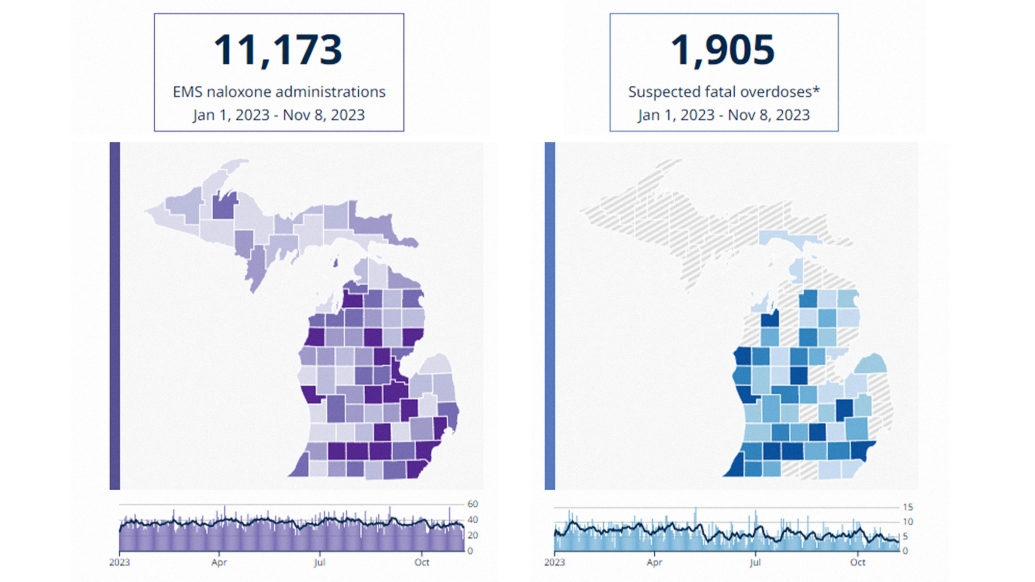The usability of this web-based platform prompts expansion to new applications for firearm injury response
10:04 AM
Author |

Opioid overdose deaths have grown ten-fold in Michigan since 2000, and the opioid epidemic continues to be a major public health crisis impacting thousands of Michiganders and their loved ones.
To improve coordinated community response to opioid overdoses, University of Michigan researchers are placing near-real time data in the hands of public health and safety officers.
The Michigan System for Opioid Overdose Surveillance was created in 2016 in response to the opioid crisis through a partnership between the University of Michigan Injury Prevention Center and the Michigan High Intensity Drug Trafficking Areas.
The system is housed within Michigan Medicine but has involved collaboration and/or funding from the high intensity drug trafficking areas, the Michigan Department of Health and Human Services, and other local health departments since its inception.
Before the overdose surveillance system, public health and safety officers often relied on reports from the Centers for Disease Control or state health department, which usually meant the data used for current opioid overdose response was from at least a year before and there was little empirical basis for informing near-term overdose response activities.
To remedy this, the system was developed to provide near real-time data on fatal and non-fatal opioid overdoses in Michigan along with demographic briefs.
The dashboard offers two varying levels of data access with basic information for the public and more detailed information available for public health and safety officers.
For the suspected non-fatal overdoses, data comes from Emergency Medical Service reports on cases where naloxone – a medication used for the emergency treatment of known or suspected opioid overdose – was administered.
In the suspected fatal cases, data comes from medical examiners before toxicology reports confirm the cause of death.
“Our non-fatal data coverage is statewide and the mortality data reports now cover about 60 counties and about 90% of the state’s population,” said Jason Goldstick, Ph.D., an associate professor of emergency medicine at Michigan Medicine.
Between 2019 and 2023, the Injury Prevention Center conducted four qualitative studies with the City of Detroit, Washtenaw County, Kent County and Genesee County which involved gathering feedback from community stakeholders involved in overdose response and prevention directly on how to tailor the dashboard to their needs, and how those data can be used to eliminate barriers and facilitate coordinated community response.
“After locating local stakeholders, we provided a SOS login as well as weekly reports to let them get a sense of how the dashboard functions and how they can use it for their goals,” said Keara Sullivan, M.P.H., project manager for SOS, about the design on those qualitative studies.
The researchers followed up with one-on-one interviews and focus groups to ask for feedback and pinpoint what about the platform was useful.
“The feedback tends to be positive,” said Sullivan.
“Easy to operate is the number one positive feedback that we receive.”
The future
The system’s dashboard is now holding steady as it covers much of the state, says Goldstick, but the project team does strive to add medical examiners from small rural counties not yet reporting data.
The dashboard model has been so successful that it’s expanding to other public health and safety applications.
“The Institute for Firearm Injury Prevention at the University of Michigan is working on a surveillance system modeled after SOS that will focus on firearm injuries in the state,” said Goldstick.
This dashboard, which is currently still in a prototype phase, will have a greater focus on intent, distinguishing between self-harm and interpersonal violence.
The Michigan System for Opioid Overdose Surveillance model is even crossing state lines as the Injury Prevention Center is partnering with the Medical College of Wisconsin on a project to create similar injury and opioid overdose surveillance dashboards.
The user testimonials speak for themselves on how near real-time opioid overdose information has impacted coordinated community response.
“I shared the [Michigan System for Opioid Overdose Surveillance ] with our [teams], and it generated a lot of discussion of where we could focus our energy around harm reduction,” said one outreach organization.
“The numbers have been going up. We need to start seeing them come down, and it’s the responsibility of all of us. We all have a role to play,” said a local public health department.
Additional resources
- The SOS Video Tutorial provides information on how authorized stakeholders can use the dashboard.
- The Michigan Safer Opioid Prescribing Toolkit provides Michigan providers with up to date resources, guidelines and strategies for managing acute and chronic pain.
- The Injury Prevention Center provides an open learning online course, Impacting the Opioid Crisis: Prevention, Education, and Practice for Non-Prescribing Providers.

Explore a variety of health care news & stories by visiting the Health Lab home page for more articles.

Department of Communication at Michigan Medicine
Want top health & research news weekly? Sign up for Health Lab’s newsletters today!





